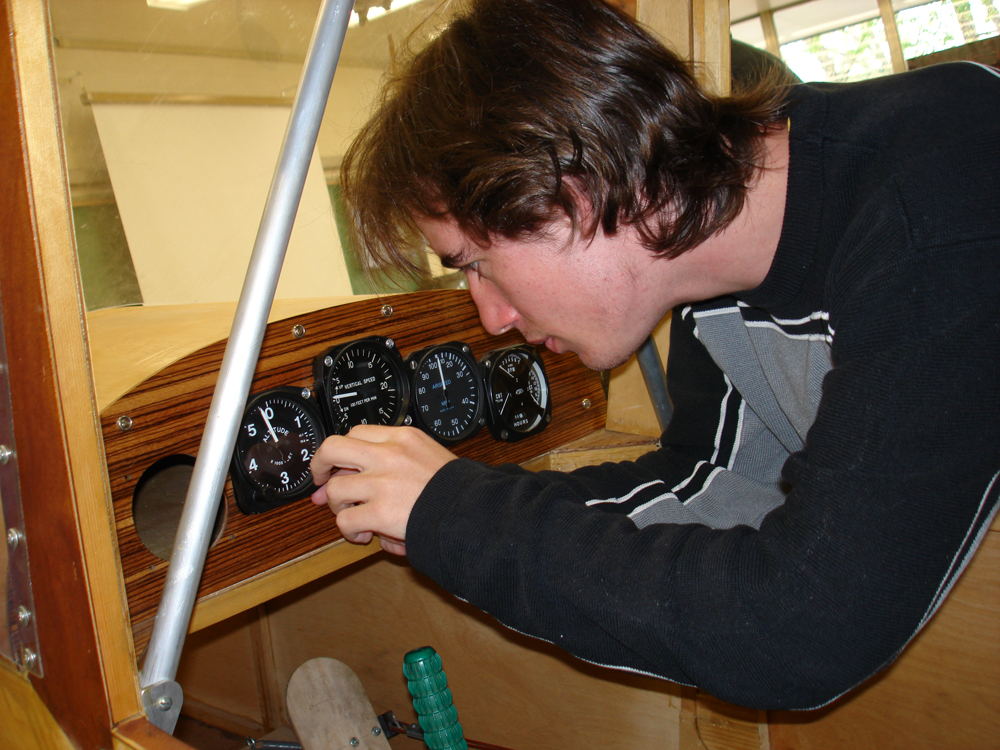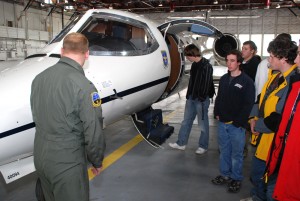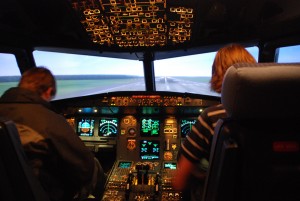By Ray Cober
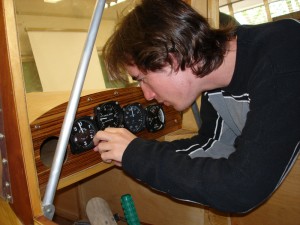
Ben Williams adjusts an instrument panel on a kit plane assembled by his class at Englewood High School.
The path to become a professional aviator can seem murky and expensive, especially to high school students with only vague concepts about flight. The Arapahoe Career Technical School and its Aviation Technology Program, offered through a variety of Colorado public school districts, including Englewood and Cherry Creek, offer such students a leg up by giving them an introduction to the ins and outs of aviation.
Teacher Joe Suchman uses a variety of instructional tools and techniques to teach the fundamentals of flight. Standard instructional materials are used, many provided by Jeppesen, based in Englewood, and the Pilot Shop, located at Centennial Airport. In addition, the class also features computer simulators equipped with Microsoft Flight Simulator X and realistic yokes, foot pedal rudder controls and full throttle and propeller controls. Students already taking flight lessons use these simulators to apply lessons learned from training. Others use them for flight planning, in their large final project of the year. The project is intended to utilize all the skills learned in the class.
“The project incorporates all of the facts we’ve learned throughout the year and unites them into one main report,” says Mike Turner, the aviation club’s 2006-2007 vice president. “It takes the abstract learning and applies it to real world situations.”
Turner is planning a flight more than 350 nautical miles long. It begins at Chicago O’Hare International Airport, continues to Fort Wayne, Ind., and then over the Appalachian Mountains to Pittsburgh, Pa., and finally to John F. Kennedy International Airport in New York City. He admits the flight is “slightly unrealistic,” due to the number of heavily congested, large airports.
“They’re airports where Cessnas never go, but would be fun to fly into,” Turner explains.
He says it’s good practice.
“It’s more hands-on, after learning so much dry and abstract information,” he explains. “We apply it to a real-world scenario to exercise skills we’ll be using for the rest of our careers.”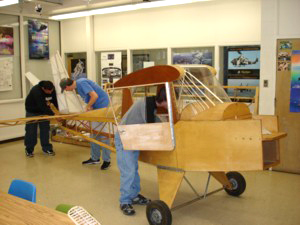
This flight-planning assignment is designed to be as realistic as possible. Students use real Cessna 172XP pilot’s operating handbooks to calculate fuel consumption and speed. They also use flight and magnetic plotters, flight calculators and plan sheets and navigational sectional charts.
Students must use all the navigational skills provided to them, with “dead reckoning” and timed segments, visual checkpoints and waypoints and advanced instrument navigation techniques, such as radials and beacons. They also calculate weight and balance issues and use Federal Aviation Administration-approved, real-time, online weather information sources. They calculate performance issues, such as landing and takeoff distances, speeds and climb and descent rates. They must be prepared for emergency landings during randomly assigned flight failures. With all these considerations, it takes little time for the students to fill sectional charts with flight routes and calculations. Suchman is more than willing to lend a hand, helping students find a checkpoint or deal with a mid-flight engine failure.
“Joe is a good teacher,” says student Patrick Snyder.
Origins
Suchman has been running the program for the past eight years, but the program itself has been around for almost 20 years, as part of what was known originally as the Arapahoe Vocational Program. According to Carol O’Brien, program director, the Arapahoe/Douglas Career and Technical School has been operating for 30 years and encompasses a number of different school districts—Cherry Creek, Douglas County, Englewood, Littleton and Sheridan—in addition to Arapahoe Community College, which oversees the overall program and curriculum. Colorado Northwestern Community College and Metropolitan State College of Denver, both with strong aviation career programs, are also involved with the ACTS Aviation Technology class.
“The Arapahoe/Douglas Career and Technical School started in 1977, when individuals from five different school districts came together to form a career technical education program,” says Mike Moore, Cherry Creek School District’s coordinator for the program. “Their plan was very expensive, and districts couldn’t afford programs like that.”
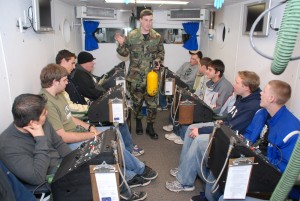
Students sit in the high altitude chamber while being taught about altitude sickness at Peterson Air Force Base.
The districts answered this concern by getting together with Arapahoe Community College, and with the help of the college, formulating a plan to work and coordinate together. For example, the Douglas County School District sends students to the Cherry Creek School District to take classes not offered in Douglas County, such as equine science.
Suchman is happy to be working with the aviation program.
“I was a pilot and teacher, and as soon as the position opened up, I applied for it,” he says. “Ever since I was a kid, I wanted to fly; I always wanted to be an astronaut and a pilot. I teach this to live my dreams through the students. I’m pushing them to live out their dreams; I never had anybody to push me. I do it to influence kids.”
Suchman began his career as an award-winning television and news photojournalist, working for ABC News in New York. He was later assigned to cover the Kennedy Space Center at Cape Canaveral, Fla. There, he learned more about NASA and met a number of astronauts and other space program and aviation personnel. After going through a five-week “crash course” at a local ground school, he began his flight training and soon became a certified pilot. He learned about the opening at Arapahoe Career Technical School and immediately applied.
“The instructor before me died suddenly and left little in the way of notes and instructions,” said Suchman. “I had to build everything from scratch; it was rough. But I had a lot of support from the aviation community, like Jeppesen, the Pilot Shop, United Airlines and local fixed base operators.”
Contributions
ACC sponsors and runs the program but doesn’t directly oversee it, allowing flexibility in how material is presented to students. The program’s corporate sponsors have similar “hands-off” policies, but often make important direct and indirect contributions. Jeppesen wrote grants for the purchase of computer desktop flight simulators, while United Airlines allows field trips of their Stapleton facilities in Denver. There, students use full-motion simulators for such airliners as the Boeing 777 and Airbus A320; students can even log this as flight time. Local aviation businesses contribute heavily; the Pilot Shop is responsible for navigational charts and other equipment and offers student discounts on its products.
Glenn Edwards started the Aviation Technology Program in the late 1980s.
“Glenn was the coordinator for the technical and vocational education program for the Cherry Creek School District,” Moore said. “He was also a former United Airlines Boeing 727 flight engineer. While working in the aviation industry, he saw that a lot of kids were interested in aviation careers and decided to help them make things happen.”
First, Edwards had to convince the state government of Colorado that enough students would be interested and that school districts could support aviation education programs.
“By law, he had to set up a development committee,” Moore explained. “A bunch of people from the aviation industry met, developed a program and applied for state approval.”
School district officials told the state government that they wanted the program. It was approved, and Edwards got financial support. But after the school districts’ initial enthusiasm, Edwards received little in the way of additional financial support or sponsorship.
“Glenn went out and sought people who would support it, such as guest speakers,” noted Moore.
Aviation Technology program today
The program originally included both pilot and flight attendant career programs.
“After Glenn left, the flight attendant program didn’t last long, but the Aviation Technology Program is still going strong,” Moore said.
The program has since expanded beyond professional pilot education, into other aviation careers where students have shown interest.
“We can’t fully prepare students for a professional pilot career, because it’s only a ground school,” Moore said. “But the teachers have also developed curriculum to include aviation technology. Some students may not intend to fly airplanes but have other interests in the aviation industry. Some are interested in aviation information management, airframe and power plant maintenance, aviation finance, or may even want to become meteorologists. A lot of students take the class to become pilots. They’ll get a ground school education out of it, but they need to get air hours as well. Plus, they also get an awareness of other areas of aviation.”
Edwards eventually retired from his position as program coordinator and left the Aviation Technology Program under the stewardship of Tim Adams, who later retired to pursue a commercial aviation career of his own. Barry Chrysler taught the program until his sudden death from a heart attack, when the program was passed to Suchman.
Since taking charge, Suchman has added his own unique style and curriculum to the class. In his Cherry Creek High School class, a magazine rack is filled with a number of aviation publications, covering flight training, general and commercial aviation, aviation careers, space technology and aircraft sales and brokerage. He encourages students to read through them and take them home, if they’d like. In all of his classes, model aircraft hang from the ceiling, most assembled by the students.
“I use the models to help students identify specific parts and functions of aircraft, so they can have a more hands-on experience in relating to how an aircraft flies,” says Suchman. “I ask them, ‘What does this part do?’ or ‘Why does this airplane look the way it does?’ It gives them a greater understanding of aerodynamics.”
He’s taking it to the ultimate extreme in his Englewood High School class, where the students are assembling a full-size kit aircraft. Suchman also shows aviation movies, such as “The Spirit of St. Louis,” with Jimmy Stewart’s portrayal of aviation pioneer Charles Lindbergh. Students must later be able to relate and apply aviation concepts learned from the movies in written essays. All of these techniques are designed to complement the curriculum’s core material, centered on Jeppesen’s Private Pilot Manual and related ground instruction material used by many flight schools around the nation. Suchman notes that the class meets or exceeds all FAA Regulation Part 141 ground course training requirements.
Field trips, speakers and sponsors
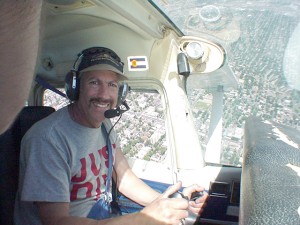
James Gardner (left) and John Heron fly an Airbus A320 simulator at the United Airlines training facility.
An important feature of the Aviation Technology Program is the annual field trip to Peterson Air Force Base in Colorado Springs, where they observe firsthand how base enlisted personnel live and work on the base. During the last trip, students were given tours of the C-130 tactical lift transports based at the field and learned about the high altitude chamber as well as hypoxia and other oxygen deprivation sicknesses. They were also allowed to dine with servicemen and women at the base’s mess hall. Other field trips have included a visit to United Airlines’ simulation and training facilities at the former Stapleton International Airport and visits to local aviation businesses, including charter companies.
Guest speakers are also an important part of the class curriculum. Airline and Air Force pilots, mechanics, air traffic controllers and other industry insiders have discussed their careers and industry paths. Notable speakers have included Air Force Academy personnel who talked about the academy and Frontier and United Airlines pilots who talked about the various types of education and career paths they took to land their dream airline careers.
In addition to all this exposure to the aviation industry offered by the program, Cherry Creek High School students also have the option to enroll in the school’s aviation club. Cherry Creek student Mike Gurwin was president of the club during the 2006-2007 academic year.
“In order to enroll in the program, you have to be at least a junior or senior,” explains Gurwin. “The purpose of the aviation club was to create a place where students could be involved prior to actually enrolling in the class.”
The club officially begins in August and ends in June, mirroring the length of the Aviation Technology Program, and is hosted after official school hours. It offers a copious amount of guest speakers and field trips, in addition to those already offered by the program.
“We have airline and military pilots, guys from Frontier and United, flight nurses, helicopter pilots, you name it,” Gurwin said. “We also have our own field trips. We visited Adam Aircraft’s manufacturing plant at Centennial Airport, where we saw them assemble airplanes like the new A500 and A700. They talked about the assembly process and the planes themselves. We visited Jeppesen’s chart-producing facility, where we saw them make instrument approach charts, airport diagrams, star charts and standard instrument departure charts. We visited the Denver Flight Service Station at Centennial, where they showed us how they do a typical weather briefing.”
The club has a variety of sponsors.
“We get a lot of support from sponsors, such as Mark Van Tine, president of Jeppesen,” Gurwin said. “He’s been very supportive of the program, in donations and supports, and is very much in favor of the club. Larry Ramsdale, president of Aspen Flying Club at Centennial Airport, offered the program and the club everything we needed. Airbus A320 Capt. John Cowan of United Airlines comes in and does guest speaking for the club and also helps organize the United simulator trips.”
Moore says it’s a great place for likeminded students to socialize.
“It’s a good place to meet people, to put faces to the voices,” says Gurwin. “The students are devoted. It’s a good group of students who really show an interest and really shine. The club and this class really influenced a lot of students to start flying. We’ve had 15 start their flight training since the beginning of the academic year.”
The future
Students who’ve gone on to pursue aviation careers include Kyle Mosher, who graduated from Suchman’s class seven years ago and is now flying for SkyWest Airlines; Samantha Covert, a 2003 graduate who is flying regional jets; and Brian Anderson, who is completing his air traffic controller requirements. Other students are currently training, flying or practicing aviation-related skills for the military, aircraft maintenance or certified flight instructors.
“I want to work to organize events and keep the club active,” said Mike Turner. “Until this past year, the club was inactive; Mike Gurwin got it jump-started. He got the field trips to Adam Aircraft and United Airlines. Part of what we try to do is incorporate different aspects of aviation, such as getting civilian pilots from airlines like Frontier, military veterans from World War II and P-51 pilots to current F-16 pilots.”
With the Aviation Technology Program, students are offered a steppingstone towards a variety of aviation careers they might not otherwise consider. Through the dedication and hard work of Suchman, the ACTS staff, devoted corporate and local sponsors and the students themselves, young people interested in aviation are able to take with them experience and knowledge that will help them launch the aviation careers of their dreams.
For more information on the Arapahoe/Douglas Career Technical School and the Aviation Technology Program, call 720-554-4462 or visit [http://www.actsinfo.org].











